Related Research Articles
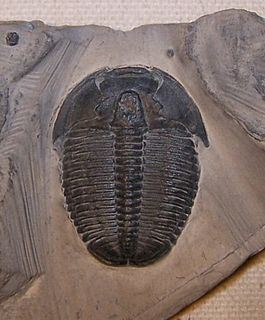
Ptychopariida is a large, heterogeneous order of trilobite containing some of the most primitive species known. The earliest species occurred in the second half of the Lower Cambrian, and the last species did not survive the Ordovician–Silurian extinction event.

Paradoxides is a genus of large to very large trilobite found throughout the world during the Middle Cambrian period. One record-breaking specimen of Paradoxides davidis, described by John William Salter in 1863, is 37 cm (15 in). The cephalon was semicircular with free cheeks ending in long, narrow, recurved spines. Eyes were crescent shaped providing an almost 360° view, but only in the horizontal plane. Its elongate thorax was composed of 19-21 segments and adorned with longish, recurved pleural spines. Its pygidium was comparatively small. Paradoxides is a characteristic Middle-Cambrian trilobite of the 'Atlantic' (Avalonian) fauna. Avalonian rocks were deposited near a small continent called Avalonia in the Paleozoic Iapetus Ocean. Avalonian beds are now in a narrow strip along the East Coast of North America, and in Europe.
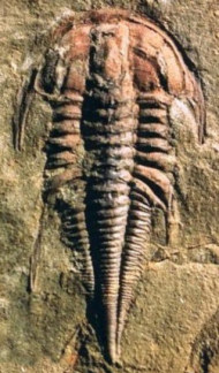
Emuellidae are a small family of trilobites, a group of extinct marine arthropods, that lived during the late Lower Cambrian of the East Gondwana supercontinent, in what are today South-Australia and Antarctica. Emuellidae can be recognized among trilobites in having a set of unique features. The headshield or cephalon has large genal spines reaching back as far as the 3rd to 6th segment of the thorax. The eye-ridges contact the back of the frontal lobe of the glabella and extend laterally and backwards, roughly parallel to the frontal and lateral rim of the cephalon. There are small, clearly incised pits at the junction between the eye-ridge and the frontal lobe of the cephalic axis. The thorax reaches its greatest width at the 6th segment. The frontal part or prothorax consists of 6 segments, with number 5 and 6 fused, and the 6th carrying very large trailing spines. The rear part or opistothorax consists of a variable but extremely large number of segments.
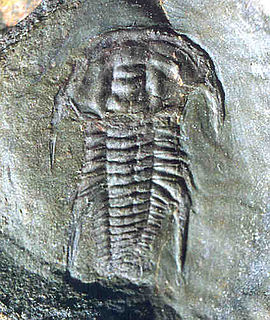
Emuella is a genus of trilobites of the family Emuellidae. Its fossils have been found in South Australia. It can be recognised by touching glabella and frontal border, and the sub-pentagonal head, as compared to, a short field between the front of the axis in the head or glabella and the border ridge, and a semi-circular headsheald in the sister-genus Balcoracania. Both emuellid genera share eye ridges that are positioned parallel to the frontal and lateral border of the head, prominent genal spines that are a smooth continuation of the lateral margin of the head, a prothorax of 6 segments, with the 5th and 6th merged and carrying large trailing spines. Both genera have in adulthood a highly variable but large number of segments of the opistothorax, although the largest number found in B. dailyi with 97 is much larger than in Emuella (52).

Olenelloides armatus is an extinct, small sized olenelloid redlichiid trilobite arthropod. It lived during the later part of the Botomian stage, which lasted from approximately 524 to 518.5 million years ago. This faunal stage was part of the Cambrian Period. The most conspicuous feature is the hexagonal head shield that carries 6 ray-like spines..
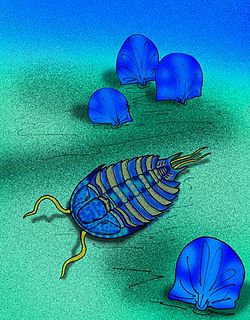
Meteoraspis is an extinct genus of ptychopariid trilobites of the family Tricrepicephalidae. The various species lived from 501 to 490 million years ago during the Dresbachian faunal stage of the late Cambrian Period. Fossils of Meteoraspis are characteristic of Late Cambrian strata in North America, though they are found in Late Cambrian strata elsewhere in the world, such as M. nevensis from Victoria Land, Antarctica.

Fallotaspis is a genus of redlichiid trilobite genus found in Early Cambrian-aged strata of the United States and Morocco.

Holmiidae is a family of trilobites, that lived during the Lower Cambrian (Atdabanian). The Holmiidae is a diverse family of eight genera containing at least 17 species. It includes some of the earliest trilobites of Baltica. Holmiidae occur throughout Baltica and Western Laurentia, and also in Morocco.

Alokistocaridae is a family of ptychopariid trilobites that lived from the Botomian epoch of the Early Cambrian until the Late Cambrian. Alokistocarids were particle feeders and left small furrows with are occasionally preserved. Their remains are found worldwide. Elrathia kingii, one of the most collected trilobites in the world, is a typical alokistocarid.

Biceratops is an extinct genus of olenelloid redlichiid trilobites, of average size, with the largest specimen 8 centimetres or 3.1 inches long, not including the huge pleural spines of the 3rd segment of the thorax. It lived during the Toyonian stage, in what is today the South-Western United States. Biceratops can easily be distinguished from other trilobites by the absence of genal spines, in combination with effaced features of the raised axial area of the head shield, that is bordering the two horn-like projections that carry the eyes. Biceratops nevadensis is the only known species in this genus.

Ptychoparia is a genus of ptychopariid trilobites, and is the type genus of the family Ptychopariidae, and the order Ptychopariida.
Mesolenellus is an extinct genus of trilobites that lived during the lower Cambrian (Botomian), found in Greenland and Spitsbergen.

Conocoryphe is a genus of primarily eyeless trilobites belonging to the family Conocoryphidae. They lived during the Middle Cambrian period, about 505 million years ago. These arthropods lived on the sea bottom (epifaunal) and lived off dead particulate organic matter.
Bolbolenellus is an extinct genus of trilobites, fossil marine arthropods, with five species attributed to it currently. It can be easily distinguished from all other trilobites by the combination of the absence of dorsal sutures in the head shield like all Olenellina, and a distinctly bulbous frontal lobe (L4) of the raised axial area in the head called glabella. The species lived at the end of the Lower Cambrian.

Eodiscina is trilobite suborder. The Eodiscina first developed near the end of the Lower Cambrian period and became extinct at the end of the Middle Cambrian. Species are tiny to small, and have a thorax of two or three segments. Eodiscina includes six families classified under one superfamily, Eodiscoidea.

Thoracocare is a minute to very small trilobite, that lived during part of the Middle Cambrian in what are today the states of Idaho, Nevada and Utah. It is the only trilobite known with just two thorax segments outside most members of the Agnostida order. It can be distinguished from Agnostida by the very wide subquadrate glabella, parallel-side or widening forward in the largest specimen, with the full front side touching the border. Two species are known, one, T. idahoensis, only from pygidia.

Cyclopygidae is a family of asaphid trilobites from the Ordovician. Cyclopygids had an extratropical distribution, and there is evidence that they lived in darker parts of the water column. Cyclopygids are characterized by enlarged eyes, with a wide angle of view, both horizontal and vertical, reminiscent of the eyes of dragonflies. These typically touch the glabella directly on the side. Cyclopygids all lack genal spines, but Symphysops carries a forward directed frontal spine on the glabella. It is presumed that at least the members of the genus Pricyclopyge swam upside down and had bioluminescent organs on the third thorax segment. Cyclopygids had between 7 and 5 thorax segments, a wide and stout axis, and short side lobes.
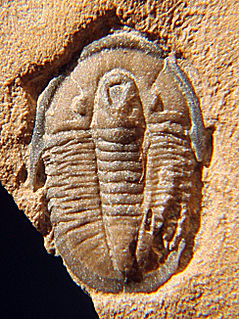
Cedaria is a small, rather flat trilobite with an oval outline, a headshield and tailshield of approximately the same size, 7 articulating segments in the middle part of the body and spines at the back edges of the headshield that reach halflength of the body. Cedaria lived during the early part of the Upper Cambrian (Dresbachian), and is especially abundant in the Weeks Formation.

Tricrepicephalus is an extinct genus of ptychopariid trilobites of the family Tricrepicephalidae with species of average size. Its species lived from 501 to 490 million years ago during the Dresbachian faunal stage of the late Cambrian Period. Fossils of Tricrepicephalus are widespread in Late Cambrian deposits in North America, but is also known from one location in South-America. Tricrepicephalus has an inverted egg-shaped exoskeleton, with three characteristic pits in the fold that parallels the margin of the headshield just in front of the central raised area. The articulating middle part of the body has 12 segments and the tailshield carries two long, tubular, curved pygidial spines that are reminiscent of earwig's pincers that rise backwards from the plain of the body at approximately 30°.

Telephinidae is a family of pelagic trilobites with large wide-angle eyes, occupying most of the free cheeks, downward directed facial spines and 9-10 thorax segments. The family is known during the entire Ordovician and occurred in deep water around the globe.
References
- ↑ Paterson, J.R. (2005). "Systematics of the Cambrian trilobite family Nepeidae, with revision of Australian species". Palaeontology. 48 (3): 479–517. doi: 10.1111/j.1475-4983.2005.00467.x .
| | This Ptychopariida-related article is a stub. You can help Wikipedia by expanding it. |